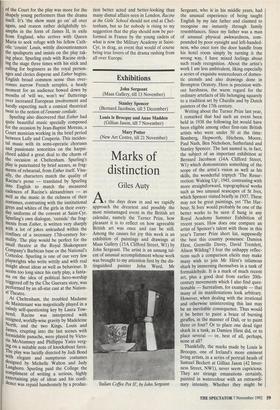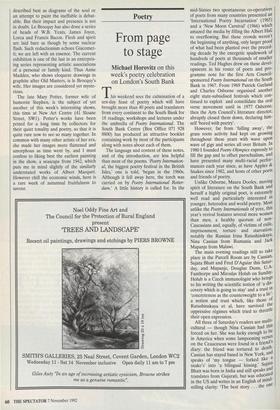Exhibitions
John Sergeant (Maas Gallery, till 13 November) Stanley Spencer
(Bernard Jacobson, till 5 December)
Louis le Brocquy and Anne Madden (Gillian Jason, till 7 November) Mary Potter (New Art Centre, till 21 November)
Marks of distinction
Giles Auty
As the days draw in and we rapidly approach the dreariest and possibly the most mismanaged event in the British art calendar, namely the Turner Prize, how pleasant it is to reflect on how agreeable British art was once and can be still. Among the causes for joy this week is an exhibition of paintings and drawings at Maas Gallery (15A Clifford Street, W1) by John Sergeant. The artist is an unsung tal- ent of unusual accomplishment whose work was brought to my attention first by the dis- tinguished painter John Ward. Mr 'Italian Coffee Pot II', by John Sergeant Sergeant, who is in his middle years, had the unusual experience of being taught English by my late father and claimed to recognise me instantly through family resemblances. Since my father was a man of unusual physical awkwardness, com- pounded by.poor eyesight and left-handed- ness, who once tore the door handle from his hotel room simply by turning it the wrong way, I have mixed feelings about such ready recognition. About the artist's work I am less ambivalent, liking especially a series of exquisite watercolours of domes- tic utensils and also drawings done in Brompton Oratory. Here is precision with- out harshness, the warm regard for the ordinary artefacts of life belonging squarely to a tradition set by Chardin and by Dutch painters of the 17th century.
Writing about the Turner Prize last year, I remarked that had such an event been held in 1938 the following list would have been eligible among other first-rate British artists who were under 50 at the time: Bomberg, Hepworth, Hitchens, Moore, Paul Nash, Ben Nicholson, Sutherland and Stanley Spencer. The last named is, in fact, the subject of an important exhibition at Bernard Jacobson (14A Clifford Street, W1) which demonstrates something of the scope of the artist's vision as well as his skills, the wonderful triptych 'The Resur- rection: Waking Up', 1945, contrasting with more straightforward, topographical works such as two unusual seascapes of St Ives, which Spencer visited briefly in 1937. These may not be great paintings, yet 'The Har- bour, St Ives' would probably be one of the better works to be seen if hung in any Royal Academy Summer Exhibition of recent years. How does one compare an artist of Spencer's talent with those in this year's Turner Prize short list, supposedly the best this country possesses: Damien Hirst, Grenville Davey, David Tremlett, Alison Wilding? I fear the unhappy reflec- tions such a comparison elicits may make many wish to join Mr Hirst's infamous shark by immersing themselves in a tank of formaldehyde. It is a mark of much recent art, plus a good deal from earlier 20th- century movements which I also find ques- tionable — Surrealism, for example — that many of its manifestations look arbitrary. However, when dealing with the irrational and otherwise uninteresting this last may be an inevitable consequence. Thus would it be better to paint a brace of burning giraffes, in the manner of Dali, or to paint three or four? Or to place one dead tiger shark in a tank, as Damien Hirst did, or to place several — or, best of all, perhaps, none at all?
Thankfully, the marks made by Louis le Brocquy, one of Ireland's more eminent living artists, in a series of portrait heads of Samuel Beckett at Gillian Jason (42 Inver- ness Street, NW1), never seem capricious. They are strange emanations certainly, painted in watercolour with an extraordi- nary intensity. Whether they might be described best as diagrams of the soul or an attempt to paint the ineffable is debat- able. But their impact and presence is not in doubt. Le Brocquy has also done a series of heads of W.B. Yeats, James Joyce, Lorca and Francis Bacon. Flesh and spirit are laid bare as though by some nuclear flash. Such reductionism echoes Giacomet- ti; we are left with an essence. The current exhibition is one of the last in an enterpris- ing series representing artistic associations of a personal or family kind. Thus Anne Madden, who shows eloquent drawings in graphite after Old Masters, is le Brocquy's wife.. Her images are considered yet myste- rious.
The late Mary Potter, former wife of humorist Stephen, is the subject of yet another of this week's interesting shows, this time at New Art Centre (41 Sloane Street, SW1). Potter's works have been prized for a long time by collectors for their quiet tonality and poetry, so that it is quite rare now to see so many together. In common with many other artists of her era, she made her images more flattened and amorphous as time went by, and I must confess to liking best the earliest painting in the show, a seascape from 1942, which puts me in mind slightly of the similarly understated works of Albert Marquet. However chill the economic winds, here is a rare week of autumnal fruitfulness to savour.











































































 Previous page
Previous page